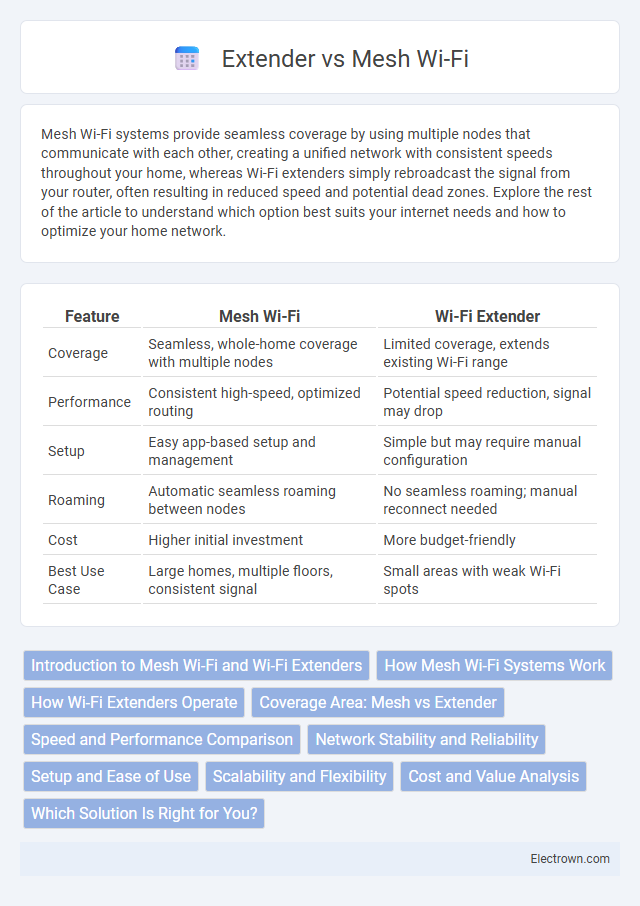Mesh Wi-Fi systems provide seamless coverage by using multiple nodes that communicate with each other, creating a unified network with consistent speeds throughout your home, whereas Wi-Fi extenders simply rebroadcast the signal from your router, often resulting in reduced speed and potential dead zones. Explore the rest of the article to understand which option best suits your internet needs and how to optimize your home network.
Table of Comparison
| Feature | Mesh Wi-Fi | Wi-Fi Extender |
|---|---|---|
| Coverage | Seamless, whole-home coverage with multiple nodes | Limited coverage, extends existing Wi-Fi range |
| Performance | Consistent high-speed, optimized routing | Potential speed reduction, signal may drop |
| Setup | Easy app-based setup and management | Simple but may require manual configuration |
| Roaming | Automatic seamless roaming between nodes | No seamless roaming; manual reconnect needed |
| Cost | Higher initial investment | More budget-friendly |
| Best Use Case | Large homes, multiple floors, consistent signal | Small areas with weak Wi-Fi spots |
Introduction to Mesh Wi-Fi and Wi-Fi Extenders
Mesh Wi-Fi systems create a seamless wireless network by using multiple interconnected nodes that provide consistent coverage throughout your home or office. Wi-Fi extenders amplify the existing signal from a single router to reach areas with weak connectivity, but may result in slower speeds and spotty coverage. Understanding the differences helps you choose the best solution for improving Your wireless network's reliability and performance.
How Mesh Wi-Fi Systems Work
Mesh Wi-Fi systems use multiple nodes that communicate with each other to create a seamless wireless network, providing consistent coverage throughout your home or office. Unlike traditional Wi-Fi extenders that rebroadcast signals and may cause dead zones or drops, mesh nodes dynamically route data through the fastest and strongest path. This technology ensures reliable internet connectivity across large areas without the need to switch networks manually.
How Wi-Fi Extenders Operate
Wi-Fi extenders operate by receiving your existing wireless signal and retransmitting it to areas with weak coverage, effectively expanding your network's reach. These devices connect to your main router either wirelessly or via Ethernet, repeating the signal to reduce dead zones in your home or office. While extenders improve coverage, they may slightly decrease overall speed due to signal rebroadcasting, unlike mesh Wi-Fi systems that maintain consistent performance across all nodes.
Coverage Area: Mesh vs Extender
Mesh Wi-Fi systems provide seamless coverage across large areas by using multiple nodes that communicate with each other to eliminate dead zones and maintain consistent signal strength. Unlike extenders, which simply rebroadcast the existing Wi-Fi signal and can create separate networks with weaker signals at the edges, mesh networks offer unified coverage ideal for entire homes or offices. Your choice should consider that mesh Wi-Fi delivers more reliable performance over wider coverage areas compared to traditional Wi-Fi extenders.
Speed and Performance Comparison
Mesh Wi-Fi systems deliver consistent high-speed coverage by using multiple nodes that communicate seamlessly, minimizing signal loss and latency across your entire home or office. In contrast, Wi-Fi extenders often reduce bandwidth and introduce lag because they rely on repeating the original router's signal, which can create network bottlenecks and weaker performance in distant areas. Your choice between mesh and extender impacts the overall speed and reliability of your wireless network, making mesh systems the better option for demanding applications and larger spaces.
Network Stability and Reliability
Mesh Wi-Fi systems provide superior network stability and reliability by using multiple nodes that communicate seamlessly, ensuring consistent coverage and reducing dead zones in large or complex home environments. Unlike traditional extenders that create separate networks and often cause drops in connection quality or speed, mesh networks maintain a single SSID, allowing devices to switch automatically to the strongest node without interruption. This integrated approach minimizes latency and packet loss, delivering a dependable and stable internet experience throughout the entire coverage area.
Setup and Ease of Use
Mesh Wi-Fi systems provide a seamless, user-friendly setup through intuitive mobile apps that guide users step-by-step, automatically optimizing network connections and eliminating dead zones. In contrast, extenders require manual configuration and placement, often involving complex wireless settings and separate network names, which can lead to inconsistent coverage and user frustration. Mesh networks maintain a single unified SSID, simplifying device connectivity and ensuring a smoother, more reliable user experience.
Scalability and Flexibility
Mesh Wi-Fi systems offer superior scalability and flexibility by allowing you to seamlessly add nodes that work together as a single network, providing consistent coverage across large or multi-story homes. In contrast, Wi-Fi extenders create separate networks with potential signal drops and require manual switching between networks as you move through your space. Your best choice depends on whether you need easy expansion and uniform connectivity (mesh) or a simple, lower-cost boost for limited areas (extender).
Cost and Value Analysis
Mesh Wi-Fi systems generally have a higher upfront cost compared to Wi-Fi extenders, but they offer better overall value by providing seamless coverage and improved network reliability throughout larger areas. Extenders are more budget-friendly initially but often result in signal degradation and require multiple units to cover larger spaces, diminishing their cost-effectiveness. Evaluating long-term performance and scalability, mesh networks deliver superior investment returns for households or offices seeking consistent Wi-Fi connectivity.
Which Solution Is Right for You?
Choosing between Mesh Wi-Fi and a Wi-Fi extender depends on your home's size, layout, and internet usage needs. Mesh Wi-Fi systems provide seamless coverage across large or multi-story homes by using multiple nodes that communicate to eliminate dead zones, while extenders rebroadcast your existing signal, often creating separate networks and potential speed drops. Assess Your specific environment and device requirements to ensure reliable connectivity and optimal Wi-Fi performance.
Mesh Wi-Fi vs Extender Infographic

 electrown.com
electrown.com